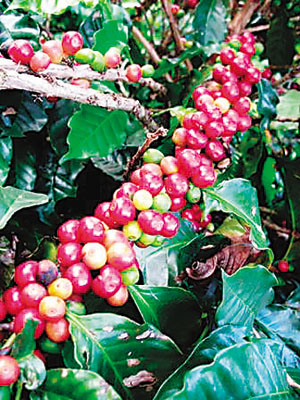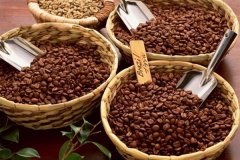Thai Coffee Malaysia Coffee Laos Coffee Robusta Coffee Lana Coffee (Lanna Cafe)
Coffee visit to Southeast Asia-Malaysian Coffee.
Malaysia has more in common with Singapore in cafe culture and coffee drinking, but Malaysia is the only Liberica coffee producer in the world outside West Africa. This kind of coffee is rich in aroma and light in flavor, accounting for less than 2% of the world's cultivation. The taste of this coffee is not acceptable to everyone, so its market is weaker than that of Arabica or Robusta. Malaysians are also gradually abandoning the cultivation of this kind of coffee, or switching to other varieties, of course, more people choose oil palm. And Liberika coffee is becoming more and more weak, even in Malaysia, it is only enough for self-sale.
The most famous of the new old-fashioned coffee chains in Malaysia is Old Town, which has made Ipoh White Coffee the representative of Malaysian coffee. Cafes such as Typica in Kuala Lumpur still roast the dwindling Liberika coffee by hand, bringing it back to its roots and sometimes paying three times as much for beans, allowing growers to keep it. Traditional Liberika coffee is roasted with sugar to make it darker and drink without sugar.
White coffee from Indonesia is roasted with no sugar but only butter, so it is relatively light in color. Compared with local coffee, white coffee does not have a long history. It first came from Ipoh (Malaysia's fourth largest city, mostly Chinese. Cantonese is the lingua franca). In the early years, it was famous for tin mines, and most of the French settled in, and the first Chinese to come here were tin miners. The so-called Old Town is generally known as the old street farm of Ipo. there are also several of the oldest Kopitiam, Xinyuanlong, Xinyuanfeng and Nanxiang, which can eat orthodox white coffee, which is not much different from the traditional Kopitiam.
Coffee visit to Southeast Asia-Laos Coffee.
Laos produces the best coffee in the world. Laos did not grow coffee for a long time, and it was not introduced by the French until the early 20th century, but its unique natural environment made Laos the king of the best coffee in Southeast Asia. Laos coffee is famous for its delicate and complex aroma and rich taste, with citrus fruit and floral aromas in the aftertaste, with a hint of chocolate sweetness, fresh and gentle taste.
Laos coffee is produced in the plateau of Bolaven, which occupies Barcelona province in the south, and is basically distributed around Basong, so Basong is called the coffee capital of Laos. The latitude here is about 15 degrees, the altitude is more than 1300 meters, the climate is suitable, the rainfall is abundant, and the rich nutrition of volcanic ash geology creates unique conditions for this kind of Southeast Asian coffee. At first, all coffee grown in Laos was Arabica. Later, about 80% of the coffee grown in Laos was changed to Robusta because of diseases, and now Arabica coffee is being replanted.
The production of coffee in Laos is already small, and Arabica sells almost all its own coffee to France, a relationship that has not changed since colonial times. Robusta coffee is exported to Nestl é in Thailand. Basong does not have many large plantations, most small farmers produce, November-January is the harvest time for Arabica coffee, and February-March is the Robsta harvest time. Laotians also like to pour coffee into a glass mixed with condensed milk, and then have another cup of green tea.

Coffee visit in Southeast Asia-Thai Coffee.
Coffee was introduced later in Chiang Mai and Chiang Lai provinces in northern Thailand than in Laos because opium poppies were no longer grown. As the former Golden Triangle town, northern Thailand has always been one of the bases of Kunsha, and the mountains are covered with poppies. And the soil suitable for growing opium poppy is always suitable for growing high-quality coffee or tea. Since drugs were swept out of Thailand in the 1980s, the high mountains around Chiang Rai have been covered with tea or coffee plantations because of royal renovation projects. Lanna Cafe coffee was grown by NGO in 1997. There are many local NGO projects, environmental protection projects and royal projects. Tourists can participate and contribute their work in order to find a new way out for local farmers after wiping out the drug trade.
Important Notice :
前街咖啡 FrontStreet Coffee has moved to new addredd:
FrontStreet Coffee Address: 315,Donghua East Road,GuangZhou
Tel:020 38364473
- Prev
Southeast Asian coffee Indonesian coffee Java coffee full-bodied boutique coffee
Southeast Asian coffee visiting tour Indonesian coffee. Indonesia has always been one of the best coffee producers in the world. Java coffee used to be synonymous with top coffee, while Sumatra and Sulawesi are also rich in top coffee. Coffee was introduced by the Dutch in the 17th century, when Ceylon (Sri Lanka) began to grow coffee, all Arabica coffee. This kind of coffee
- Next

Vietnamese Coffee Vietnamese Coffee Flavors Unique Butter Roasted Coffee Beans Vietnamese Coffee Flavors
Southeast asia coffee visit vietnam coffee. In Vietnam, drinking coffee between friends is as natural as shaking hands. A cafe in three or five steps is not only a street scene in Vietnamese cities, but also seems to be a ceremony and an important way of socializing, while Vietnamese only drink tea at home. Vietnam, colonized by France for many years, was deeply influenced not only by the language, but also by the way coffee was drunk.
Related
- What documents do you need to go through to open a coffee shop? coffee shop coffee shop certificate processing process
- How to purchase Coffee beans in small Cafe how to choose a suitable supplier for domestic Coffee supply Company
- How to drink Starbucks Fragrance White Coffee? how to make Australian White Coffee? what Italian coffee beans are recommended?
- The Story of Flora Coffee: the name of Flora Coffee Bean and the implication of the Flowers on Florna Coffee
- How much does a cup of coffee cost? How much is the profit of a cup of coffee? What is the profit of the coffee shop in a year?
- Yunnan small Coffee, known as "fragrant Coffee", introduces the characteristics of Alpine Arabica Coffee producing areas in Yunnan, China
- 2023 latest Starbucks full menu price list how much is a cup of Starbucks coffee what is better to drink the most popular hot and cold drinks recommended
- Starbucks different kinds of Coffee Price list Starbucks menu 2023 Top Ten Best drinks in Starbucks
- Starbucks Spring praise Comprehensive matching Coffee Bean theme Story Packaging implication and taste description
- The cost of a cup of coffee latte American coffee cost price and selling price

